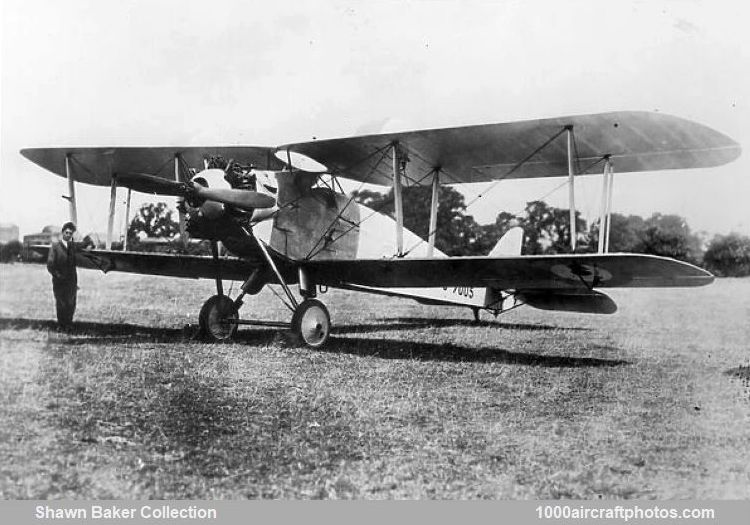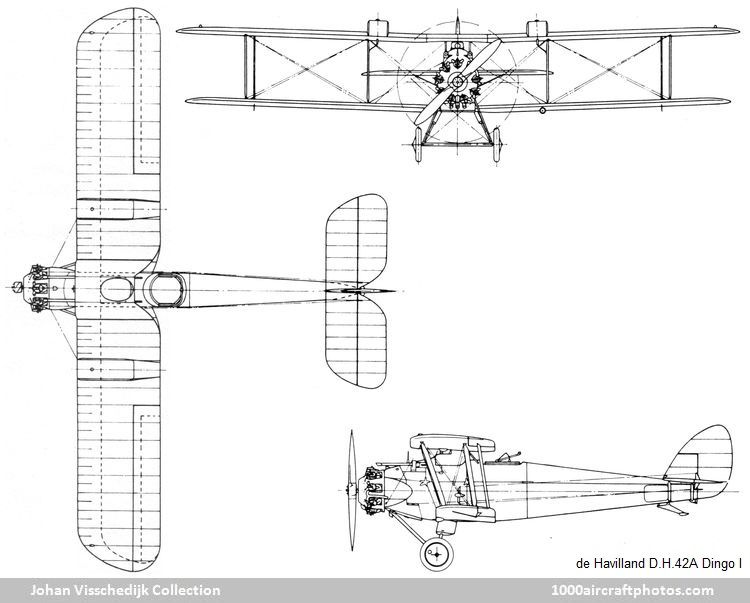06/30/2024. Remarks by Johan Visschedijk: "The Dormouse was a high performance, two seat, reconnaissance fighter designed to Air Ministry D. of R. (Directorate of Research) Specification Type 22/22. The single prototype was built on standard de Havilland lines, with fuselage of spruce longerons and cross pieces covered with plywood, oleo damped undercarriage and variable incidence tailplane of the type first fitted to the D.H.11 Oxford. Upper and lower mainplanes were of unequal span and the narrow chord of the lower gave the front interplane struts a considerable forward slope.
For maximum view the pilot's cockpit, entered by a door on the starboard side, was placed high up to afford a commanding view in all upward directions through a large oval cutout in the top center section. Seated behind the pilot, the gunner, operating a 0.303 in (7.7 mm) Lewis machine gun on a Scarff ring, had an equally good view forward and upward by a generous V-shaped trailing edge gap. Two 0.303 in (7.7 mm) Vickers synchronized machine guns were fitted on the nose of the aircraft.
Powered by a 360 hp Armstrong Siddeley Jaguar II fourteen-cylinder air-cooled radial engine and serialed J7005, the Dormouse was first flown at Stag Lane Aerodrome, on July 25, 1923 and made its public debut in the New Types Park at the Hendon RAF Display on June 28, 1924 alongside the Vickers 94 Venture I and Bristol 52 Bullfinch which had been built to the same specification. The Dormouse J7005 was delivered by air from Stag Lane to the RAE, Farnborough on March 27, 1925 for use by the Wireless and Photographic Flight and before being written off charge at the end of the year, was used for various W/T and magneto screening tests.
Already in 1924, an Army Co-Operation version to D. of R. Specification Type 8/24 and known as the D.H.42A Dingo I (serialed J7006, c/n 85) had been built. As a result of fitting the large diameter 410 hp Bristol Jupiter III nine-cylinder air-cooled radial engine, the front fuselage differed considerably from that of the Dormouse. The two forward firing guns were no longer housed in neat tunnels but were fitted externally to fire over the engine. Front center section struts which raked inwards at the top on the Dormouse were splayed out on the Dingo and the large oval cutout over the pilot's seat was reduced to a smaller circular opening. The gunner's trailing edge gap was, on the other hand, cut right back to the rear spar and increased to fuselage width.
The reduction of the pilot's aperture on the Dormouse to the size of that on the Dingo, was one of a number of modifications made in January 1925 before this aircraft was put through a new series of tests with a 420 hp Armstrong Siddeley Jaguar IV fourteen-cylinder two-row air-cooled radial engine, driving various airscrews and at a variety of all-up weights. The two synchronized machine guns were replaced with one firing through the engine shaft, while the Dingo had provision for four 112 lb (51 kg) bombs.
The D.H.42A Dingo I flew for the first time on March 12, 1924, however, only three months later it was lost when it broke-up over RAF Northolt on June 5.
The D.H.42A Dingo I was followed by a third prototype, serialed J7007 (c/n 115) and designated D.H.42B Dingo II, it was first flown by Hubert Broad (who had also tested the previous aircraft) on September 29, 1926. The Dingo II was similar to Dingo I and also intended for Army Co-Operation duties but differed from both the previous aircraft, being of steel instead of wooden construction.
Although the original drawings called for an Armstrong Siddeley Jaguar, the actual engine fitted was a 436 hp Bristol Jupiter IV installed with full exhaust manifold and long exhaust pipes of the type used on the Bristol 89. Gravity feed was used on all three D.H.42 machines, fuel being carried in two large airfoil section tanks on top of the upper mainplane. Those of the Dingo II were larger and this aircraft was also equipped with an elementary device under the rear fuselage for picking up messages. The Dingo II was delivered to Farnborough on November 16, 1926."

